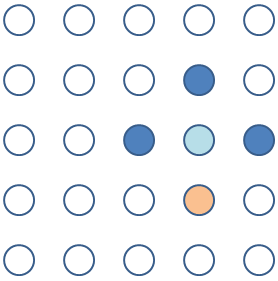Batch 3 - Class 174 - Square It
Pre-Class Exercise
- (536Dudeney - 266) An officer wished to form his men into 12 rows, with 11 men in each row, so that he could place himself at a point that would be equidistant from every row. However, there were only 120 men. Was it possible to carry out the order?
- Answer: The men may be arranged along rows as shown, with the officer at the center
.png)
Attendance Muskaan, Arjun, Kushagra, Vaazisth, Aashvi, Anshi
Class puzzles
Square it
Players take turns to click on a dot on a 5x5 grid - first player's dots are blue and second red. The winner is the first to have four dots that can be joined by straight lines to form a square. Squares can be any size and can be tilted.
- Let kids play the game and come up with observations and winning strategies
- How can you tell if four dots make a square - what kind of squares exist on the board?
- Describe your winning strategies
- What kind of variations can you play with?
Discussion:
- Forking seems like a good winning strategy.
- There is a 2-fork by making a T symbol. However, if the second person spots if early, they can block it
- Actually this is a 3-fork if you look at larger square possible. However it takes 4 turns to get to it, so the other party can see it forming
.png)
- Can you start to force the other person towards certain moves and still form forks
- There is also a 3-fork one can get to with three moves instead of 4. Here the red is forced by the third move, and then the blue can move to create a two fork

- Can we do this in a manner where red is stuck by the second move itself?
- What if we put first in center, and then the second just off on one of the diagonals? Now depending on where the red goes, we can force the game on the other side.
.png)
- What happens if you play the game on larger grids? Smaller?
Squares from Diagonals
We have a grid of dots, and we draw a random line connecting two points. That line is a diagonal of some square.
- Do the other two vertices of this square lie on the grid?
- How do you determine this?
- How do you quickly determine what those points are?
Let kids do some examples on a grid of paper, and observe patterns. Let them find some diagonals for which the corresponding vertices are on the grid and some which are off. Can you spot the pattern?
Can you form a hypothesis of whats going on? Can you prove/ reason that? (if kids can't get there, provide them with a hint to look at the size of diagonal, or those of component "sides" on the grid; give them the hint of looking pythagoras)
Discussion
Kids may notice that when both component "sides" are even or both are odd, then the vertices are on-grid, otherwise not. Correspondingly, when diagonal^2 is even, the vertices are on-grid, else not
.png)
See diagram above. Since a and b are odd/odd or even/even, (a-b)/2 and (a+b)/2 are integral, which means the corresponding point lies on the grid. Also sum of squares of these is the square of the bold red line's size, and exactly half of the diag^2. Hence this red bold line must be side of the square constructed by the diagonal.
Can you think conversely. What happens if a and b are odd/even. Even in that case, the vertex of the square is governed by (a+b)/2 and (a-b)/2. However those points are now not on the grid.
Homework Problem:
- (Dudeney - 368) A man had a ten-gallon keg full of wine and a jug. One day he drew off a jugfull of wine and filled the keg with water. Later on, when the wine and water had got thoroughly mixed, he drew off another jugful and again filled up the keg with water. It was then found that the keg contained equal proportions of wine and water. What was the capacity of the jug?
- Answer: 2.93 gallons
References:
https://ia902701.us.archive.org/4/items/AmusementsInMathematicspdf/AmusementsInMathematics.pdf - Dudeney